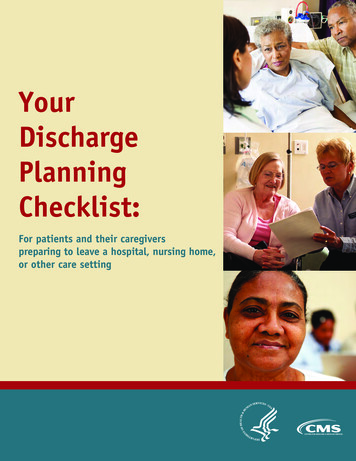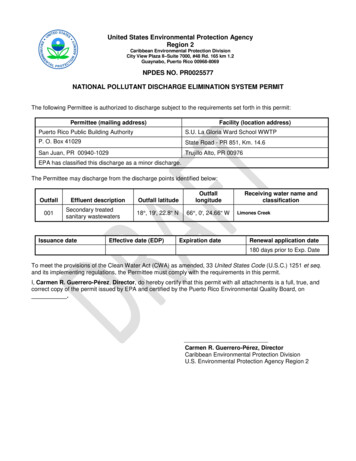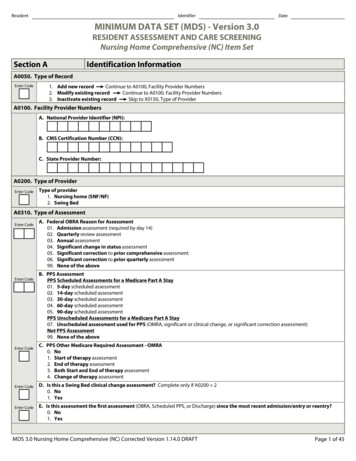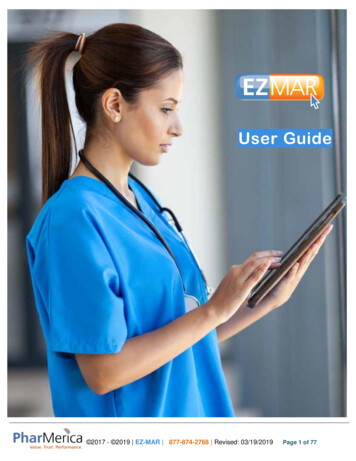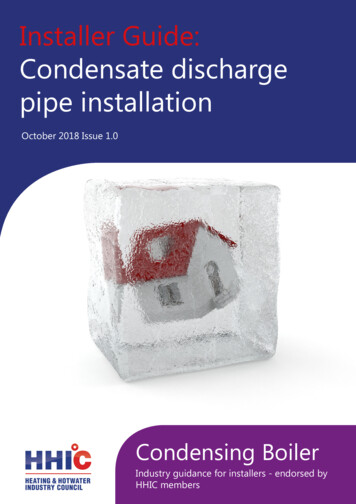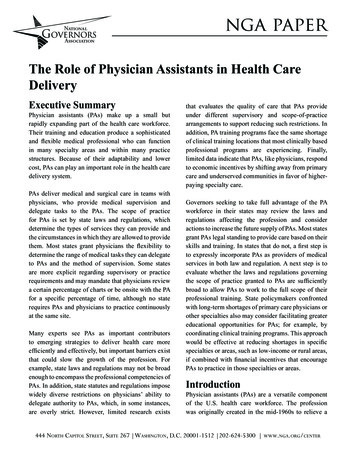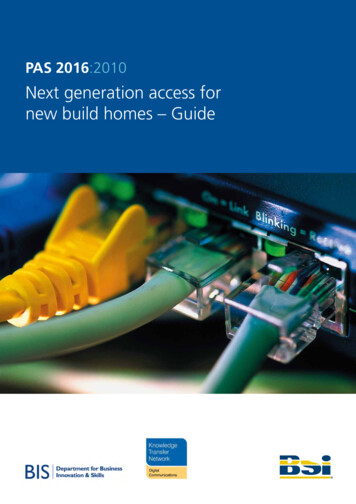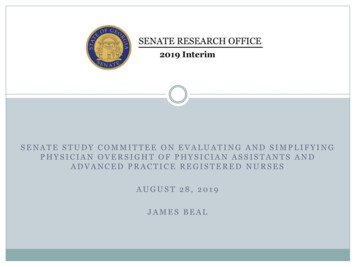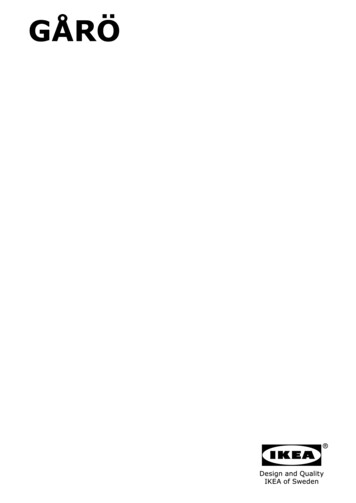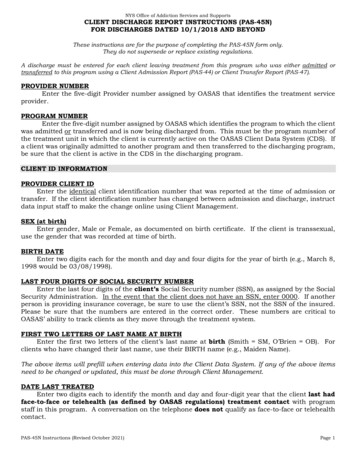
Transcription
NYS Office of Addiction Services and SupportsCLIENT DISCHARGE REPORT INSTRUCTIONS (PAS-45N)FOR DISCHARGES DATED 10/1/2018 AND BEYONDThese instructions are for the purpose of completing the PAS-45N form only.They do not supersede or replace existing regulations.A discharge must be entered for each client leaving treatment from this program who was either admitted ortransferred to this program using a Client Admission Report (PAS-44) or Client Transfer Report (PAS-47).PROVIDER NUMBEREnter the five-digit Provider number assigned by OASAS that identifies the treatment serviceprovider.PROGRAM NUMBEREnter the five-digit number assigned by OASAS which identifies the program to which the clientwas admitted or transferred and is now being discharged from. This must be the program number ofthe treatment unit in which the client is currently active on the OASAS Client Data System (CDS). Ifa client was originally admitted to another program and then transferred to the discharging program,be sure that the client is active in the CDS in the discharging program.CLIENT ID INFORMATIONPROVIDER CLIENT IDEnter the identical client identification number that was reported at the time of admission ortransfer. If the client identification number has changed between admission and discharge, instructdata input staff to make the change online using Client Management.SEX (at birth)Enter gender, Male or Female, as documented on birth certificate. If the client is transsexual,use the gender that was recorded at time of birth.BIRTH DATEEnter two digits each for the month and day and four digits for the year of birth (e.g., March 8,1998 would be 03/08/1998).ULAST FOUR DIGITS OF SOCIAL SECURITY NUMBEREnter the last four digits of the client’s Social Security number (SSN), as assigned by the SocialSecurity Administration. In the event that the client does not have an SSN, enter 0000. If anotherperson is providing insurance coverage, be sure to use the client’s SSN, not the SSN of the insured.Please be sure that the numbers are entered in the correct order. These numbers are critical toOASAS’ ability to track clients as they move through the treatment system.FIRST TWO LETTERS OF LAST NAME AT BIRTHEnter the first two letters of the client’s last name at birth (Smith SM, O’Brien OB). Forclients who have changed their last name, use their BIRTH name (e.g., Maiden Name).The above items will prefill when entering data into the Client Data System. If any of the above itemsneed to be changed or updated, this must be done through Client Management.DATE LAST TREATEDEnter two digits each to identify the month and day and four-digit year that the client last hadface-to-face or telehealth (as defined by OASAS regulations) treatment contact with programstaff in this program. A conversation on the telephone does not qualify as face-to-face or telehealthcontact.PAS-45N Instructions (Revised October 2021)Page 1
NYS Office of Addiction Services and SupportsCLIENT DISCHARGE REPORT INSTRUCTIONS (PAS-45N)FOR DISCHARGES DATED 10/1/2018 AND BEYONDFor inpatient/residential programs, the client should be discharged after three (3) days of nocontact unless special arrangements have been made between the client and program staff withthe understanding that they will be returning to your program (e.g., following hospitalization ordetox).For opioid treatment programs, a client should be discharged retroactive to the date of lastmedication pick-up or the date last treated, whichever is later.For other Part 822 Outpatient programs, a client normally should be discharged retroactive tothe date of last face-to-face or telehealth treatment contact if there is no face-to-face ortelehealth contact within sixty (60) days, unless special arrangements have been made betweenthe client and program staff with the understanding that they will be returning to your program(e.g., following hospitalization or detox).For all the above, the actual discharge date should be retroactive to the date of last face-toface or telehealth treatment contact.PART 820 PROGRAM ELEMENT INFORMATIONDays per element of care and/or setting will automatically be displayed. No data needs to beentered for these items. Calculations are based on data submitted at time of admission andtransitions/transfers as applicable. If totals appear incorrect, please review the transaction historyfor this client in Client Management.The elements of a Part 820 residential services include the The settings for the Reintegration element of a Part 820 residential service include thefollowing:CongregateScatter-SiteLOCADTR INFORMATIONBoth Assessment ID and Created Date are optional items and can be entered at the program’sdiscretion.Assessment IDThe Level of Care for Alcohol and Drug Treatment Referral (LOCADTR) 3.0 Assessment ID willbe generated at the administration of LOCADTR 3.0 to substantiate the clinical rationale fordischarge. The most recent Assessment ID should be documented. It can be found on theAssessment Dashboard page of LOCADTR 3.0 and is the first column next to Client name. Theassessment ID will appear on the assessment table located on the LOCADTR dashboard only for theclinician who completed the assessment. If a person uses the “Other Clinicians’ option to retrievethis information, they will have to download the CSV file to get the Assessment ID number.The use of LOCADTR 3.0 Protocol has been mandated for all OASAS certified substance usedisorder treatment providers to be utilized to determine the most appropriate level of care for a clientand therefore it must be utilized for all admissions, transfers, transitions, and discharges. Furtherinformation on LOCADTR 3.0 can be found here- LOCADTR 3.0.PAS-45N Instructions (Revised October 2021)Page 2
NYS Office of Addiction Services and SupportsCLIENT DISCHARGE REPORT INSTRUCTIONS (PAS-45N)FOR DISCHARGES DATED 10/1/2018 AND BEYONDCREATED DATEThe Created Date is the date the LOCADTR 3.0 assessment is created and supports thisdischarge. Enter two digits for the month, two digits for the day, and four digits for the year.EDUCATION AT DISCHARGEIndicate the client’s highest grade completed at discharge (this must be the same or greater thanthe grade entered at admission). If the grade entered at admission was incorrect, update theadmission transaction with the correct information prior to entering this discharge transaction. Ifthe client is in a special education class, select the grade that most accurately reflects the client’slevel of performance.No Education01 to Grade 11 – Indicate grade completedHigh School DiplomaGeneral Equivalency Diploma (GED)Vocational Certificate w/o Diploma/GEDVocational Certificate with Diploma/GED (A Vocational Certificate is any certificate receivedas a result of vocational training or special skill trade.)Some College - No DegreeAssociate DegreeBachelor’s DegreeGraduate DegreeEMPLOYMENTEMPLOYMENT STATUSIndicate the client’s current employment status or the status that will immediately followdischarge. If a client may be counted in more than one category, choose the status which mostappropriately indicates their employment status, except for individuals attending primary orsecondary school. See examples below. A client working off-the-books or in a volunteerposition is not considered employed.Employed Full-Time – 35 Hrs per Week Use this status for active military personnel.Employed Part-Time – 35 Hrs per WeekEmployed in Sheltered WorkshopUnemployed, Looking for Work This status should only be used if the client has actively soughtemployment within the last 30 days.Unemployed, Not Looking for Work Programs may use this status for clients who are working off-the-books or in a volunteer position.Not in Labor Force – Child Care issuesNot in Labor Force – Disabled The client has been assessed and identified as disabled and isnot required to work pending the results of an application for SSI benefits for publicassistance purposes.Not in Labor Force – In Training To be used when a client is unemployed but taking part in aformal training program such as a program via ACCES-VR, Department of Labor, BOCES,etc. This includes if a client has a scheduled appointment to engage in a program at one ofthe above-mentioned training programs.Not in Labor Force – Inmate Can be used if the client is in a jail-based or prison-based program.Not in Labor Force – RetiredPAS-45N Instructions (Revised October 2021)Page 3
NYS Office of Addiction Services and SupportsCLIENT DISCHARGE REPORT INSTRUCTIONS (PAS-45N)FOR DISCHARGES DATED 10/1/2018 AND BEYONDNot in Labor Force – Student Use this status if the client is engaged in school, including postsecondaryeducation or GED studies, and is not employed or if the client is employed, but engaged inprimary or secondary education (K-12).Not in Labor Force – OtherSocial Services Work Experience Program (WEP) A specific set of work/work related tasks towhich a public assistance recipient is assigned for a specific number of hours per week bya local Social Services District as a condition for receipt of a public assistance grant and/orrelated benefit.Social Services Determined, Not Employed/Able to Work The client is seeking or is on PublicAssistance and has been assessed by treatment program staff or an OASAS credentialedindividual acting on behalf of a local Social Services District as able to engage in work, butis not employed at the time of discharge.Social Services Determined, Unable to Work, Mandated Treatment The client has beenassessed by an OASAS credentialed individual acting on behalf of a local Social ServicesDistrict as unable to work and was in treatment as a condition for receiving publicassistance.Unknown (use if client is lost to contact)LENGTH OF EMPLOYMENT AT DISCHARGESelect the category that best represents the number of consecutive days that the client hasbeen employed at their current job at the time of discharge. If you have indicated that the client isemployed, but the client will not be starting employment until after the actual discharge date, selectthe “0-30 Days” category.0-30 Days31-60 Days61-90 Days91-120 Days121 DaysTYPE OF RESIDENCEEnter the category that best describes the client’s current residence (outpatient) or the residencethat the client will be going to immediately after discharge from this program (inpatient/residential).Private ResidenceHomeless, Shelter Includes a person or family, who is undomiciled, has no fixed address, lacksa regular nighttime residence, and is residing in some type of temporary accommodation (i.e.,hotel, shelter, residential program for the victims of domestic violence).Homeless, No Shelter Includes a person or family who is undomiciled, has no fixed address,lacks a regular nighttime residence, and circulates among acquaintances, or is residing in aplace not designed or originally used as a regular sleeping accommodation for human beings.Single Resident Occupancy Hotel, rooming house, adult home, or residence for adultsResidential Services for SUD*/Congregate A community living experience in one location withonsite staff available seven days a week, twenty-four hours a day, such as a communityresidence or Part 820 residential program.Residential Services for SUD/Scatter-Site A community living experience where housing isprovided at various locations where staff provide, at a minimum, case management andsupervision through weekly in-house visits. Examples include supportive living or Part 820residential programs with a reintegration setting of scatter-site.MH/DD Community Residence Mental Health/Developmental Disabilities CommunityResidence.Other Group Residential Setting Other Group Residential may include group homes, supervisedapartments, and college housing or military barracks.PAS-45N Instructions (Revised October 2021)Page 4
NYS Office of Addiction Services and SupportsCLIENT DISCHARGE REPORT INSTRUCTIONS (PAS-45N)FOR DISCHARGES DATED 10/1/2018 AND BEYONDInstitution, Other (e.g., jail, hospital)Other*SUD Substance Use DisorderLIVING ARRANGEMENTSIndicate what the client’s living arrangements will be after discharge.Living AloneLiving with Non-Related PersonsLiving with Spouse/RelativesPRIMARY PAYMENT SOURCEIndicate the primary source of payment for the client’s treatment in this program.Funding received from OASAS or other sources and not attributable to a specific client shouldnot be included as a primary payment source. The primary payment source reflects payments fromthe client or other sources based upon the client’s qualifications for assistance.None To be used only if there is no direct public (i.e., Medicaid, Medicare), private (i.e., healthinsurance) or client payment (i.e., self-pay).Self-PayMedicaid Inpatient Rehab, Part 822 Outpatient Services, Residential Rehabilitation Services forYouth, Opioid Treatment Programs, Medically Managed Detoxification, Medically SupervisedWithdrawal Inpatient/Outpatient, and Residential Part 820 services excluding Reintegration.Note: To be used when a provider receives a Medicaid payment in response to a claim submittedby the provider to the NYS Medicaid payment contractor.Medicaid Managed Care Inpatient Rehab, Part 822 Outpatient Services, ResidentialRehabilitation Services for Youth, Opioid Treatment Programs, Medically ManagedDetoxification, Medically Supervised Withdrawal Inpatient/Outpatient, and Residential Part820 services excluding Reintegration. To be reported when a managed care organization(MCO) has authorized reimbursement or has reimbursed the provider for a service renderedto a Medicaid recipient. An MCO is defined as any group operating or implementinghealthcare through managed care concepts of service including authorization, utilizationreview and/or a fixed network of providers. Payment under the Child Health Plus programsis included under this category.Medicaid Pending Inpatient Rehab, Part 822 Outpatient Services, Residential RehabilitationServices for Youth, Opioid Treatment Programs, Medically Managed Detoxification, MedicallySupervised Withdrawal Inpatient/Outpatient, and Residential Part 820 services excludingReintegration. To be reported when the program and/or the client has applied for Medicaid,and is anticipating that the application will be successful, but the client/program has notyet been notified that the application has been approved at the time that the client is beingdischarged from treatment.MedicareDSS Congregate Care (Residential Only) – To be used by non-Medicaid eligible residentialprograms, such as intensive residential, community residences and supportive livingprograms that received congregate care payments for the client being discharged. CongregateCare here is defined as inclusive of SSI, Safety Net and TANF. DSS Congregate Care can alsobe selected as Primary Payment Source for clients being discharged from any Part 820residential treatment program, regardless of element of care and/or the billing of MedicaidManaged Care for treatment services if the treatment program determines that DSSCongregate Care was the primary payment source for the client’s treatment.PAS-45N Instructions (Revised October 2021)Page 5
NYS Office of Addiction Services and SupportsCLIENT DISCHARGE REPORT INSTRUCTIONS (PAS-45N)FOR DISCHARGES DATED 10/1/2018 AND BEYONDDepartment of Veterans AffairsPrivate Insurance – Fee for Service To be reported when a provider receives payment for anindividual that is insured by a company that is not an MCO as defined above. Thesepayments are health insurance benefits provided through entities such as an employer,union, or a commercial or nonprofit insurer such as Metropolitan, Aetna, Blue Cross or BlueShield respectively. Private insurance benefits may be provided as an individual plan or agroup plan.Private Insurance – Managed Care To be reported when a provider has been authorized orreceives payment for an individual insured by an MCO. This code should not be used forMCO services provided to a Medicaid recipient.Other To be used only for other types of payment received directly from the client or from otherson behalf of client. NOTE: This is not to be used when programs receive net deficit fundingfrom OASAS, and the client has no payment source. Programs receiving Net Deficit fundingfrom OASAS are prohibited from denying admission to someone based on ability to pay andthose clients who are unable to pay should be documented in None.MENTAL HEALTHIndicate Yes or No to each of the following:CO-EXISTING PSYCHIATRIC DISORDERRefers either to a diagnosis of mental illness which is available to the clinician at the time ofdischarge by mental health screen, client report, significant other report, records, or by presentingsymptoms which the clinician recognizes as possibly symptomatic of mental illness. The recognitionof symptoms does not constitute a diagnosis on the part of the clinician but may indicate symptomsthat need to be addressed.EVER TREATED FOR MENTAL ILLNESSInvolves the planned intervention designed to relieve the distress and/or disability associatedwith mental illness.EVER HOSPITALIZED FOR MENTAL ILLNESSMeans the admission to some type of hospital or inpatient facility for the treatment of thedistress and/or disability associated with mental illness. If “Yes” is indicated, then “Ever Treatedfor Mental Illness” must also be “Yes.”EVER HOSPITALIZED 30 OR MORE DAYS FOR MENTAL ILLNESSMeans the admission to some type of hospital or inpatient facility for the treatment of thedistress and/or disability associated with mental illness for 30 or more consecutive days. If “Yes” isindicated, then “Ever Treated for Mental Illness” and “Ever Hospitalized for Mental Illness”must also be “Yes.”GAMBLING GOAL ACHIEVEMENTSince treatment programs serve clients with diverse needs, not all goals are applicable forevery client. The ratings assigned to Gambling Goal Achievement must be supported by informationdocumented in the client record.Goals established should be based on client identified needs and clinically appropriateobjectives that that are achievable while in this program.If a gambling goal is not appropriate for the client, check “Not Applicable.”PAS-45N Instructions (Revised October 2021)Page 6
NYS Office of Addiction Services and SupportsCLIENT DISCHARGE REPORT INSTRUCTIONS (PAS-45N)FOR DISCHARGES DATED 10/1/2018 AND BEYONDBase the rating of goal achievement on (1) counselor observation and/or (2) client report and/or(3) case records. If a client is lost to contact, the rating should be based on the informationpossessed during the client’s last treatment contact with program staff or other reliableinformation (e.g., a few days after the client was last at the program, an article in the newspaperreports that they were arrested for participating in illegal gambling activities).The ratings for Gambling Goal Achievement recognize that clients may achieve a portion of aparticular goal.If a gambling goal is identified as anything other than “Not Applicable,” the goal must bedocument in the client’s treatment/recovery plan. If a gambling goal is not documentedin the client’s treatment/recovery plan, Gambling Goal Achievement must be identifiedas “Not Applicable.”The achievement of the client’s gambling goal (if any) is not currently linked to theDischarge Status of “Completed Treatment: All treatment goals met” and “CompletedTreatment: Half or more treatment goals met.” In other words, if a client does not achievetheir gambling goal, the program can still report that the client Completed Treatment: Alltreatment goals met, and the gambling goal is not included when counting whether halfor more of the treatment goals have been met. There is no system edit linking gamblinggoal achievement and Discharge Status.For the client’s gambling goal, make a judgment regarding whether the goal of this area was met:Achieved – The goal(s) was fully met.Partial Achievement – Some of the objectives were fully met, others were partially met; orall were partially met.Not Achieved – None of the objectives were fully or partially met.Not Applicable – It was not appropriate to set a treatment goal for gambling.NICOTINE GOAL ACHIEVEMENTSince treatment programs serve clients with diverse needs, not all goals are applicablefor every client. The ratings assigned to Nicotine Goal Achievement must be supported byinformation documented in the client record.Goals established should be based on client identified needs and clinically appropriateobjectives that are achievable while in this program.If a nicotine goal is not appropriate for the client, check “Not Applicable.”Base the rating of goal achievement on (1) counselor observation and/or (2) client report and/or(3) case records. If a client is lost to contact, the rating should be based on the informationpossessed during the client’s last treatment contact with program staff or other reliableinformation.The ratings for Nicotine Goal Achievement recognize that clients may achieve a portion of aparticular goal.If a nicotine goal is identified as anything other than “Not Applicable,” the goal must bedocumented in the client’s treatment/recovery plan. If a nicotine goal is not documentedPAS-45N Instructions (Revised October 2021)Page 7
NYS Office of Addiction Services and SupportsCLIENT DISCHARGE REPORT INSTRUCTIONS (PAS-45N)FOR DISCHARGES DATED 10/1/2018 AND BEYONDin the client’s treatment/recovery plan, Nicotine Goal Achievement must be identified as“Not Applicable.”The achievement of the client’s nicotine goal (if any) is not currently linked to theDischarge Status of “Completed Treatment: All treatment goals met” and “CompletedTreatment: Half or more treatment goals met.” In other words, if a client does not achievetheir nicotine goal, the program can still report that the client Completed Treatment: Alltreatment goals met, and the nicotine goal is not included when counting whether half ormore of the treatment goals have been met. There is no system edit linking nicotine goalachievement and Discharge Status.For the client’s nicotine goal, make a judgment regarding whether the goal of this area was met:Achieved – The goal(s) was fully met.Partial Achievement – Some of the objectives were fully met, others were partially met; orall were partially met.Not Achieved – None of the objectives were fully or partially met.Not Applicable – It was not appropriate to set a treatment goal for nicotine.Total Treatment Visits and Counseling Sessions are for Outpatient Programs Only – ExcludingOpioid Treatment Programs)TOTAL TREATMENT VISITSEnter the total number of treatment visits reported since admission during which treatmentservices were provided (For clients transferred in, treatment visits must include those occurring inthe program from which the client was transferred). Only one treatment visit can be reported perclient per day, regardless of the number of different treatment services provided to the clienton that day.Treatment services are defined as post admission clinical and medical services provided insupport of the individual’s indicated goals of treatment. Treatment services may include but are notlimited to Medication Management, Counseling, Peer Advocate, and Physical Health Services. ATreatment Visit may be counted when one or more treatment services are provided to a client byprogram staff on a specified day and are documented in the client’s case record.COUNSELING SESSIONSEnter the total number of Individual Counseling Sessions, Group Counseling Sessions andFamily Counseling Sessions that this client attended while in treatment in this program.INDIVIDUAL COUNSELING SESSIONS1.Must be 25 minutes or more in duration.2.Must be provided on or after the client’s admission date and prior to or on the client’s dischargedate.3.Counselor may report more than one session per day per individual client although this wouldbe unusual.4.Is usually scheduled but may be provided as needed.5.May include psychotherapy, and post-admission evaluation.6.Does not include pre-admission assessment sessions.GROUP COUNSELING SESSIONS1.Must be 60 minutes or more in duration.PAS-45N Instructions (Revised October 2021)Page 8
NYS Office of Addiction Services and SupportsCLIENT DISCHARGE REPORT INSTRUCTIONS (PAS-45N)FOR DISCHARGES DATED 10/1/2018 AND BEYOND2.3.4.Includes general group counseling, specialty group counseling, *family group counseling.Is almost always scheduled.May report more than one group session per day.FAMILY COUNSELING SESSIONS *1.Must be delivered by any direct care staff to a client (primary or significant other) and theirfamily or significant other.2.Must be 30 minutes or more in duration.3.Must be provided on or after the client’s admission date and prior to or on the client’s dischargedate.4.Direct care staff may report more than one session per day per family/couple.5.Is usually scheduled but may be provided as needed.6.May include couples counseling and *family counseling.7.Does not include pre-admission assessment sessions.* With or without presence of primary client.Recent History: Six Months Prior to DischargePlease provide information based on the client’s experience during the Current TreatmentEpisode in this program. If the current treatment episode was longer than six months, provideinformation based on the client’s experience during the six-month period prior to discharge. If thecurrent treatment episode was less than six months, count the client’s experience only while inthis program for this episode.Example: If the client was in treatment for two months, provide information based on that periodonly. If the client was in treatment for two years, provide information based on the past six months.NUMBER OF ARRESTS IN PRIOR 30 DAYSEnter the number of arrests in the 30 days prior to discharge. An arrest should be countedif the client was legally processed and detained while in treatment. If the client has been in yourprogram for less than 30 days, enter the number of arrests during their time in the program.NUMBER OF ARRESTS IN 6 MONTHS PRIOR TO DISCHARGEEnter the number of arrests in the 6 months prior to discharge. An arrest should be countedif the client was legally processed and detained while in treatment. Any arrest that the client had inthe last 30 days, will also be counted here since the last 30 days is part of the last 6 months. If theclient has been in your program for less than 6 months, enter the number of arrests during their timein the program.NUMBER OF DAYS INCARCERATED IN 6 MONTHS PRIOR TO DISCHARGEEnter the number of whole or partial days that the client was remanded to jail or prisonwhile in treatment in the 6 months prior to discharge. This number cannot exceed the numberof days the client was in treatment in this program.NUMBER OF DAYS HOSPITALIZED IN THE 6 MONTHS PRIOR TO DISCHARGEEnter the number of whole days that the client spent in a hospital for medical or psychiatricconditions in the 6 months prior to discharge. If the client has been in your program for less than 6months, enter the number of days hospitalized during their time in the program.NUMBER OF DAYS IN INPATIENT DETOX IN THE 6 MONTHS PRIOR TO DISCHARGEPAS-45N Instructions (Revised October 2021)Page 9
NYS Office of Addiction Services and SupportsCLIENT DISCHARGE REPORT INSTRUCTIONS (PAS-45N)FOR DISCHARGES DATED 10/1/2018 AND BEYONDEnter the number of days that the client spent in inpatient detoxification during the 6 monthsprior to discharge. If the client has been in your program for less than 6 months, enter the numberof days in inpatient detox during their time in the program.NUMBER OF EMERGENCY ROOM EPISODES FOR WHICH THE CLIENT RECEIVED TREATMENTIN THE 6 MONTHS PRIOR TO DISCHARGEEnter the number of separate incidences in which the client used emergency room services inthe 6 months prior to discharge. If the client has been in your program for less than 6 months, enterthe number of emergency room episodes during their time in the program.STATUS OF ALCOHOL AND OTHER DRUG USE AT DISCHARGESTATUS OF SUBSTANCES REPORTED AT ADMISSIONSUBSTANCEThe primary, secondary and tertiary substances reported at admission will be pre-filled by thesystem based on information entered on the client’s admission form (PAS-44N).FREQUENCY OF USE AT DISCHARGEEnter the frequency of use in the 30 days prior to the last treatment contact. If the client hasbeen in the program for less than 30 days or normal treatment cycle is less than 30 days, enterthe frequency of use during their time in the program. If the client has been in treatment lessthan 30 days and has not used any substances, select “No use in last 30 days.” If the client is lost tocontact before the frequency of use in the last 30 days (prior to the last treatment contact) can bedetermined, the counselor should estimate the frequency of use based on the best informationavailable. This is a federally mandated item, and they do not permit a choice of “Unknown.”No use in last 30 days (note: or while in program if less than 30 days)1-3 times in last 30 days1-2 times per week3-6 times per weekDailySTATUS OF DIFFERENT PROBLEM SUBSTANCES USED BY THE CLIENT BUT NOT REPORTEDAT ADMISSION (IF ANY)SUBSTANCEUp to three additional substances may be identified. The order should be determined byclinical judgment, history and frequency of use, client’s perception, medical issues and problem areasof client functioning. These may be substances beyond the three used/reported at admission and/orsubstances that the client began to use after admission. If no such substances were identified, pleasecheck “None.”NoneAlcoholCocaineCrack This is the street name for a more purified form of cocaine that is smoked.Marijuana/Hashish This includes THC and any other cannabis sativa preparations.Synthetic Cannabinoids (e.g. K2/Spice)HeroinBuprenorphinePAS-45N Instructions (Revised October 2021)Page 10
NYS Office of Addiction Services and SupportsCLIENT DISCHARGE REPORT INS
NYS Office of A ddiction Services and Supports CLIENT DISCHARGE REPORT INSTRUCTIONS (PAS-45N) FOR DISCHARGES DATED 10/1/2018 AND BEYOND. PAS-45N Instructions (Revised October 2021) Page 1 . These instructions are for the purpose of completing the PAS-45N form only. They do not supersede or replace existing regulations.

